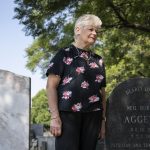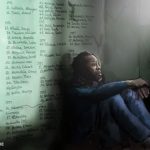Aggett inquest told of electrocution and suffocation
Six men held at John Vorster Square at the time of Neil Aggett’s death recount harrowing stories of abuse and torture at the hands of the Security Branch.
Author:
6 February 2020

The testimony given by former detainees and comrades of Neil Aggett during the reopened inquest into his death has, according to Nishaan Bolton, “given South Africans the clearest example of what non-racialism in struggle is all about”.
Bolton, the executive director of the Ahmed Kathrada Foundation at the time, was addressing the small group of family, friends and media gathered at the activist’s grave on the morning of 5 February 2020, the 38th anniversary of his death.
Over the course of the past week, a group of men from across the political and social spectrum – many of them former or current members of the postapartheid government – have come to courtroom 8F at the Johannesburg High Court to tell the stories of what happened to them at the hands of the former regime’s security police. Far away from their families and loved ones, many were kept in the cold, grey offices on the 10th floor of John Vorster Square. They were held under the provisions of draconian laws intended to ensure no one would know what was happening to them as they were subjected to beatings, threats of electrocution, wet-bag torture and other terrible humiliations.
Related article:
Some of these men risked further harassment when they gave evidence at the original inquest into Aggett’s death in 1982. Others were unable to testify because they were serving time in prison. Many of them are now able to say things not permissible at the time, potentially helping the court piece together what happened during that fatal detention at John Vorster Square.
If the iniquities, humiliation and physical torment that the court has thus far heard were inflicted on the men who survived, what hellish punishments may have been visited on the man who did not?
If all of them were not allowed anything in their cells, besides the bare minimum of a polystyrene cup and a Bible, how is it that Aggett was allowed a host of items, including books and the kikoi cloth he allegedly used to hang himself, as was claimed by the security police during the first inquest?
Many of the men claim they saw obvious signs of physical abuse and beatings on Aggett’s body and that his spirits were diminished until he seemed “zombielike”. So how was it possible for magistrate Petrus Kotze to come to the conclusion that the security police were not in the least bit liable, either directly or indirectly, for his death?
For those men who did not know Aggett well or who had only came face to face with him for a brief moment during their interrogations, he is a reminder of the great sacrifices made by many in the struggle against the brutality and injustice of apartheid.
For his family and those who knew him, he remains a dedicated humanitarian whose life was cut tragically short at the age of 28 and who would never have resorted to suicide. As one of his comrades adamantly told Aggett’s sister this week when she asked him if he believed her brother had killed himself, “No way! That man was too strong.”
Frank Chikane
Frank Chikane, former director general of the presidency in the Thabo Mbeki administration, told Judge MA Makume that his detention in December 1981 was the fourth and longest period of interrogation by the security police since his first arrest in 1977.
He described beatings and humiliation. He was kept awake for days, hung upside down and threatened by his interrogators with the same fate as Roodepoort activist and teacher Ahmed Timol, the first person to die in detention at John Vorster Square after “throwing himself” out of the window of a 10th floor office in October 1971.
Chikane’s 1981 detention would coincide with the death of Aggett in February 1982 and the subsequent death of Ernest Dipale, who was found hanged in his cell in August that year.
Related article:
Although Chikane did not know Aggett at the time of his detention, he had heard of him and saw him on 1 February 1982 through the peephole of his cell. Chikane characterised Aggett as he came back from interrogation: “He was not in a good state. He was walking slower than usual and bending forward, clearly struggling to walk. … I suspect he was in pain and very weak.” This sight of Aggett is an “image … etched in my mind because it was the last time I saw him”.
He believes that Aggett, like many of his fellow detainees, “knew and understood they were there for a greater cause, [which] gave them greater resolve and made it harder for them to break psychologically. I firmly believe that Neil was one of those people [who] was committed to his cause and I do not think he would have broken easily or was suicidal.”
Prema Naidoo
Prema Naidoo, 74, wears a hearing aid, the result of an injury he received while in detention in 1981, when Aggett’s chief interrogator, Stephan Whitehead, hit him on his ear, which caused it to ring for the rest of his life.
At the time of his arrest in November 1981, Naidoo was the assistant secretary of the Transvaal chapter of the Anti-South African Indian Council (SAIC) Campaign, which had been engaged in protest against the Indian council elections set up by the apartheid government.
Naidoo recalled that upon arrival at John Vorster Square on 27 November 1981, he was taken to the office of Security Branch commander Major Arthur “Benoni” Cronwright who proceeded to hit Naidoo in the face and pull his hair. He told him that when he and his men were done, they would rename the building “Prema Naidoo Heights”, a reference to their other nickname for the office: “Timol Heights”.
Later, Naidoo’s wrists were handcuffed to his ankles, and he was beaten again. Eventually he was taken to the Vereeniging Police Station, where he recalls: “The officers then gave me a pink liquid that they said was Sanatogen. I was told that Sanatogen would calm your nerves. Sanatogen was advertised as a tonic in those days. But I am not sure whether it was actually Sanatogen. I drank it. I then began speaking about things I should not have spoken about. I think I was not given Sanatogen but the so-called truth serum.”
Related article:
In 1979, Naidoo was involved in assisting activist Stephen Lee escape from Pretoria Prison – the subject of the forthcoming film Escape from Pretoria starring Daniel Radcliffe – and after six days of brutal interrogation and sleep deprivation, he told his captors of his role in Lee’s escape.
Naidoo never knew or met Aggett, but in February 1982, he was taken from Vereeniging to the 10th floor of John Vorster Square, where he received a brief visit from his wife.
In the police van on the way back to Vereeniging, Naidoo saw a newspaper placard announcing an activist had died. It was only on his return to Vereeniging when a police officer gave him a copy of The Citizen that he learned of Aggett’s death.
Naidoo survived more torture and interrogations before being charged for his involvement in Lee’s escape and sentenced to three years in prison in April 1982.
After his release, he continued to be politically active and served for many years in various capacities in the ANC in Johannesburg before retiring.
Maurice Smithers
Maurice Smithers, a community and social justice activist, was first arrested in September 1981 and detained at the Randburg Police Station. He was taken to John Vorster Square for interrogation, but Smithers was “not tortured, just asked questions”.
He was released after two weeks and then detained again in November 1981 and held in the Randburg cells. By January 1982, after being in solitary confinement for a month, Smithers said, “[I] became very restless and anxious … and desperately felt the need to get out of my cell.” To facilitate this, he broke the lens of his spectacles and requested an appointment with an optician, which he was granted on 25 January 1982.
From Randburg he was brought to the 10th floor of John Vorster Square, to office 1011, where he was left alone for about 45 minutes in the company of several black police officers.
It was during this period that Smithers looked through the rippled glass dividing the offices and saw Aggett in the adjoining room. He was being interrogated by “six or seven” officers who would walk around, asking him questions and occasionally hitting him on the head with what Smithers surmised was a rolled-up newspaper.
Smithers said he “was shocked by what [he] saw”. He was then taken to an optometrist in Hillbrow before being brought back to the same 10th floor office where Aggett’s interrogation continued.
Now Aggett appeared to be naked and was being forced to do push ups and run on the spot. His interrogators had also started hitting him with their fists as well as the rolled-up newspaper. Smithers told Judge Makhume: “[I] was really disturbed by what I was seeing, and I did not know what to do.”
Related article:
He considered picking up a chair and throwing it against the glass of office 1011 to let Aggett and his interrogators know they were being watched but decided against it. Smithers testified that Aggett’s interrogation continued for about another hour before he was made to dress and was taken out of the office. Smithers “did not see Neil other than through the ribbed glass and there was no opportunity … to speak to him”.
Still shocked, Smithers returned to his cell at Randburg where he reconstructed some of the exercises he had seen Aggett been forced to do and found after three days that he was “suffering from intense pain in my shoulders and legs and found it very difficult to walk”.
He decided to write a note about what he had witnessed and smuggle it out, but, unfortunately, no one came to see him until after Aggett’s death, at which point Smithers rewrote the note and smuggled it out to his sister in the false bottom of a matchbox. She passed it onto Progressive Party MP Helen Suzman who read the details of Aggett’s treatment out to Parliament, without divulging that Smithers was the source of the information. His identity was protected until he testified at the original inquest into Aggett’s death.
He told the court: “[I have] huge respect for Neil as a person; he was a trained doctor and could have chosen to live a comfortable middle-class life. Instead he had committed himself to the struggle, fighting for the rights of workers. He was very pleasant but also very intense and serious. He felt very strongly about what was happening in South Africa at the time.”
Ismail Momoniat
Ismail Momoniat, who currently serves as deputy director general in the National Treasury, was at the time of his arrest in 1982 a 25-year-old junior lecturer in the mathematics department at Wits University. Like Naidoo, Momoniat had been active in the Transvaal Anti-SAIC Campaign.
He was arrested in Lenasia on 20 January 1982 and taken to John Vorster Square where he was held in cell 204 of the station’s wing for the detention of political detainees, a few doors down from cell 209, where Aggett was kept. Momoniat told the court: “As political activists, we all tried to prepare ourselves for [a] solitary detention spell or interrogation. There was only one certainty – if you want to be politically active against apartheid, that sooner or later, you would be forced to be questioned or arrested by the security police, or both. We knew full well how brutal the security police were and that we could be tortured or beaten to death, and that we were physically powerless in such situations to stop them. They were an essential component of a repressive state.
“The key aim for us as political activists was not to break down and lose control in detention and hence mentally prepare ourselves for what we would tell the security police in such situations. One had to learn how to play a game with the security police, and how to deal with them, even if you were in extreme pain or stress.”
Related article:
During his interrogation, Momoniat was slapped, screamed at, threatened with the same fate as Timol, told he would be electrocuted and hit in the chest because his interrogators were aware he suffered from “a minor heart problem”. As a result of continued and increasingly threatening interrogation, Momoniat recalled that he started having problems sleeping, nightmares and depression. He often woke up in the middle of the night in a panic. “I raged internally at my powerlessness and became acutely aware of my vulnerability.”
Momoniat did not know Aggett but saw him in the corridors and cell block several times before his death. He described how, on the one occasion he was able to have a brief conversation with Aggett in his cell, “Dr Aggett said he did not think that he would be charged. He thought that the state wanted to use him as a state witness against Barbara Hogan, Cedric Mayson, Cedric de Beer and possibly others. I do not recall seeing any books or any other items in Dr Aggett’s cell – it appeared to be quite bare, as was the norm at that point.”
Momoniat said that at this first meeting, Aggett appeared to be “as relaxed as any detainee could be”, but he noticed a marked change in the doctor’s demeanour when he saw him a few days before his death. On that occasion, Aggett was uncommunicative and oblivious to what was going on around him. “[He] was in a daze and just stared blankly at the wall in front of him.” Momoniat also noticed a large mark on Aggett’s forehead, which he “will never forget … because it proved … that he had been beaten up”. Momoniat testified that after hearing of Aggett’s death, which occurred shortly after their last brief encounter, he was very upset. “I do not to this day believe that he had taken his own life and blame the Security Branch for his death. The state he was in on the day that I last saw him was proof enough that he was in no condition to end his life, which was very difficult to do.”

Firoz Cachalia
Former Gauteng MEC for Economic Development Firoz Cachalia was a 23-year-old student and political activist when he arrived at John Vorster Square in December 1981. During his interrogation on the 10th floor he could hear people screaming and shouting from other rooms. “I assumed these individuals were screaming from pain while under torture. It created a sense of fear in me.”
Under interrogation, Cachalia was slapped and beaten with hands and fists, and his testicles were squeezed; he was hit with a baton on the soles of his feet and threatened with electrocution. He was also subjected to wet-bag torture. As Cachalia described it, “This treatment would invariably be preceded by a punch to the solar plexus leaving one fighting for breath, followed by my interrogators placing a wet sack, made of cloth, over my head and holding it tight so that my breathing became impossible … I never lost consciousness but I was once taken to the point of defecating in the room … Most of the torture was designed to humiliate you – to make you feel insignificant, powerless and completely under their control.”
Related article:
Cachalia recalled that he believed “the Security Branch would beat me until I gave them what they wanted, and that they were capable of destroying me both mentally and physically. Their actions entailed an arbitrary exercise of power, and there were no ethical limits. They would do anything to protect this system of theirs. We were the enemy, and we also had no protections under the law.”
Cachalia did not know Aggett and saw him only once in John Vorster Square the day before his death. Cachalia described Aggett as “tall with a sensitive face and a gentle demeanour”. Although Aggett smiled at him, Cachalia’s impression was that “he was not coping with detention”.
When he learned of Aggett’s death, Cachalia said, “I recall feeling that Neil’s death was no surprise … because we all thought something terrible was going to happen to one or more of us.” He believes “that one of two things happened to Neil Aggett. Either he succumbed under torture when the police miscalculated and took him too far, perhaps through the wet-bag treatment; and then staged the hanging. Or the security police, through unrelenting torture and abuse, brought him to the point where he believed he had no option but to take his own life. Either way, the Security Branch are responsible for Neil Aggett’s death.”

Sisa Njikelana
Sisa Njikelana was 26 years old when he was arrested in December 1981. As the vice president of the South African Allied Workers’ Union, Njikelane knew Aggett through his work with the African Food and Canning Workers’ Union. Njikelane recalled Aggett being “very sincere [and] extremely dedicated to his union work”. The two became friends. Njikelana was arrested at Aggett’s house in May 1981. From there he was taken to John Vorster Square and detained for 10 weeks. He was then rearrested in East London in December 1981 and again brought to John Vorster for interrogation.
There he was repeatedly assaulted by Cronwright, who was unsatisfied with the statements he was writing. Njikelana described how, during one particularly aggressive session of interrogation by Lieutenants Booysen and Steyn, he had his hands chained to his ankles and was made to sit on the floor. “Booysen placed a canvas bag over my head. At this point, I could no longer see what was happening around me. I was wearing a long-sleeved shirt. I felt Booysen and Steyn rolling up my sleeves. They began binding a cloth around my upper forearms near my bicep. I felt something cold and metallic pressing on the inside of my biceps. It was at this point when I felt the first electric shocks. My entire body began to shake. I felt vibrations run through me. All I could feel was pain rippling across my entire body. I lost track of time and eventually fell over sideways. I think I passed out for a few seconds … Booysen and Steyn continued to electrocute me a number of times. I do not recall exactly how many times or how long the process took.”
Njikelana recalled that he saw Aggett a few times during their detention. On one occasion, Aggett silently drew Njikelana’s attention to a “red mark that was triangular in shape on the outside of his right forearm … Neil did not say anything. He just showed me the mark. I understood him to be communicating to me … ‘I am being tortured’, albeit non verbally.”
Related article:
The last time Njikelana saw Aggett was “during the night of 4 February 1982 or early morning of 5 February 1982”. “[I recall] being woken up by a commotion. I heard the sound of low voices and gates opening. This was very unusual given the time of night. I quickly jumped up and stood on top of my toilet to peep. That is when I saw a group of SB [Security Branch] officers carrying Neil.
“I recall how the SB officers were carrying Neil because it was the same way that Muslims carry their dead. They had lifted him up to shoulder height, with his face up and carrying him head first. Either four or six officers were carrying Neil. They were moving hastily, and I could hear their footsteps, but due to their haste, the process was completed very quickly, so I was unable to identify which officers were carrying Neil. I did manage to recognise Neil because of his distinctive beard and face.”
Njikelana believes his friend “did not voluntarily commit suicide. He was extremely committed to his work and totally dedicated to the struggle. Neil was also extremely humble. He once told me to tell workers that they should not refer to him as ‘doctor’… He did not like titles. The lasting impression I have was that Neil was committed to improving the lives of workers.”
The inquest continues.







